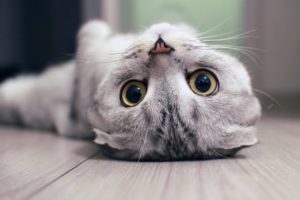
Other than photographing our kids, there’s probably nothing we enjoy photographing more than our pets–in my case my two Ragdoll cats. (In case you’ve never seen Ragdolls, they’re “giant” cats that were first bred in the 1960s. They’re big, gorgeous, even tempered, long-haired cats, with blue eyes and raccoon faces. Their name comes from the fact that they can relax so much they go limp, just like a child’s ragdoll.
Like most cat owners, some of my initial shots were of my cats playing, sleeping in the sun, chasing their own tail, or other similar cat antics. However, the more photographs I took, the more I realized my favorite shots were those where I got up close and personal–usually within a few feet of my cats. Using this up close technique, I could focus on specific features, like one eyes, both eyes, black and red ears, long whiskers, or the paws. I know most of us like seeing the whole cat in a photo, but when shots are focused on specific features, they can be extraordinarily dramatic.
For example, I have one photograph of my male Ragdoll (he has DEEP blue eyes) that focuses in on just one eye; and in that shot you can see the hint of a reflection in his eye. I think it’s a great photo–and captures the beauty of his eyes.
If you’d like to try close up shots, here are my recommendations:
1. Don’t try and get the shot when your cats are all revved up and racing through the house like a whirling dervish! Try and capture them when they’re quiet, have just eaten, or are stretched out in the sun.
2. If you have a helper, have them hold something distracting just over your shoulder. This gives the cat something to focus on besides your camera–and can hold the cat’s attention long enough to get the picture.
3. Focus in on your cat’s most distinctive features. For example, for me, it’s the eyes. Your cat may have unusual markings, perfect ears, or the longest whiskers on record. These are the features to concentrate on. Remember, the goal here is to capture a knockout art-style print, not just a snapshot of Kitty.
4. If you’re using a digital camera, set it to take multiple shots (without a delay between shots); then once you have the feature in focus, rapidly shoot several shots. This way you’ll have far better luck in capturing the perfect shot.
5. Don’t be afraid to use a slow shutter speed to capture your cat’s eyes in a blur. I’ve done this in several shots, and it can be very dramatic.
6. Avoid using a flash, or you’ll be processing the photo through PhotoShop (or other image editors) in order to remove red eye.
Good luck with your photos–and don’t forget to give your cat a treat for posing for you!

As I web-site possessor I believe the content matter here is rattling great ,
appreciate it for your hard work. You should keep it up forever!
Best of luck.
I have been surfing online greater than three hours lately, yet I never discovered any fascinating article like yours.
It’s lovely worth enough for me. Personally, if all webmasters and bloggers made good content material
as you did, the web will be much more useful than ever before.